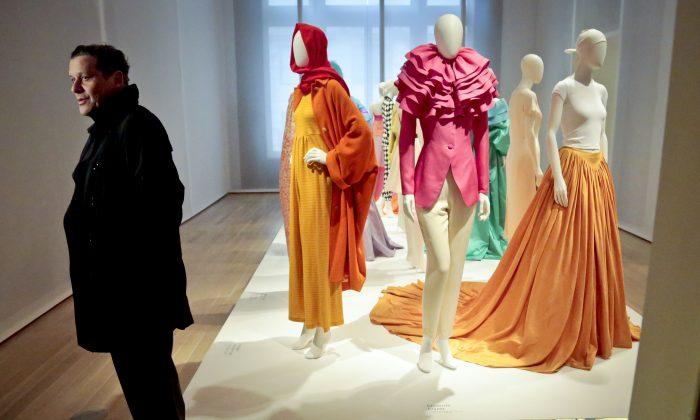NEW YORK—Don’t call the Jewish Museum exhibition on Isaac Mizrahi’s work a retrospective. Those, the 54-year-old designer said, are for dead people.
This journey through several elegant rooms on Fifth Avenue is more like a mid-career survey.

“I was very, very reticent and a little bit, kind of, shocked,” he said of his first reaction to the idea of a show just for him. “I hesitated, only because I feel as though it needed a lot of exploration and a lot of clarification.”
But away he went, slogging through his archives with the help of guest curator Chee Pearlman and others from the museum. The process brought on a touch of melancholy, but it ultimately felt cathartic, particularly dozens of sketches for many of his sartorial looks and an entire wall showing off his alphabet, his language—color groupings of fabric swatches, threads, and embellishments mounted lovingly on white board and meticulously preserved.
“It was such a crazy thing to amass all of those swatches all these years,” he said as he walked through the exhibition, ahead of its opening March 18. “And I think the sketches resonate because clothes are clothes. Sketches are wishes.”
The Brooklyn native, the former Yeshiva boy who was relentlessly bullied for being different, was barely 27 when he produced his first runway show in 1988 after his Parsons School of Design graduation and jobs in the studios of Perry Ellis, Calvin Klein, and other established mentors.
Years of runway shows and couture for the rich and famous followed, including custom work for two first ladies, Hillary Clinton and Michelle Obama, along with Sarah Jessica Parker and Meryl Streep, to name a few. His brand, Isaac Mizrahi New York, faltered in 1998, but he continued to create, embracing at times the highs and lows in terms of pricing, often in the same outfit, as his love of women of all ages and body types shined.

Mizrahi, with his signature head of dark, curly hair, created a line for Target and sells on QVC, but his creative output beyond clothes is represented at the Jewish Museum: as performer, writer, musician, and director in dance, theater, and opera. Among projects still to come is a memoir, but it’s slow-going.
When he was doing couture collections—and who knows, he said, maybe he'll make another someday—his shows were liberating, rule-breaking manifestos, little crowd-pleasing stories based on gestures that would lead to clothes bursting with color or sparkling in sequins—always meticulously crafted.
It was never about alienation, Mizrahi said. Always about pleasing women.
The designer worked before social media made over-sharers of us all, yet he once gave models hand-held cameras to shoot his audience during a live show filmed for the 1995 documentary “Unzipped.” It was an anatomy of a collection and included models changing on stage behind a transparent scrim. The same theatrical flourish is represented along the walls of the exhibit.
The film pushed Mizrahi further into the mainstream, where he continued to express just what an American designer could do absent any heavy European influence.
It was Mizrahi who once dyed standard poodles Easter egg pastels and trimmed them up like walking topiaries for the runway. He constructed a full, formal skirt out of those quilted pads that hang in freight elevators, made a standard camel-hair coat with a fur-trimmed hood as a jumpsuit instead, and crafted a red Baby Bjorn carrier to match a satin, strapless gown of the same hue, because “the birth of a child should be integrated into a woman’s social life.”
He called his clothes “quite friendly.” The last stop on his mid-career “survey” includes three roomy new coats, cut comfortably and the same but made of different fabrics, including one in oil cloth and another covered in red and pink sequins.
Coming up with “unique and new” collections of pricey couture, on a season-to-season cycle every four months, is something Mizrahi left behind.
“It takes a lot of time now to make something truly interesting,” he said. “To really make interesting clothes, interesting enough for women to consider buying them at crazy, crazy expensive prices, I do think they should be something that you haven’t seen. That is really hard.”
Pearlman, who happens to be a neighbor of Mizrahi in New York, is a long-time fan.
“If I were going to speak about a legacy for Isaac it would be about his fearlessness, and that little touch of irreverence and humor that he is just so unafraid to share,” she said March 14 in an interview as workers put the finishing touches on the show.
Mizrahi wasn’t a rule follower in high fashion, she said. And he was never boring.
“He did not give you the same thing every year. He was not afraid to give you exuberant and even clashing, crazy color. He loved stepping over those lines,” Pearlman said. “That is something that is rare and actually probably quite missed in American fashion now.”






Friends Read Free